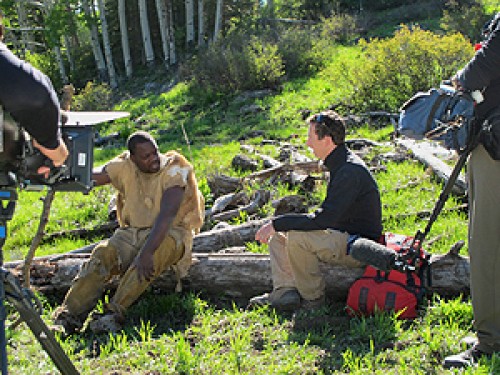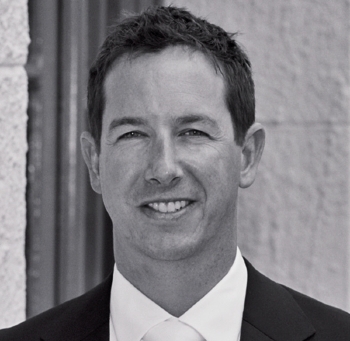Stanford physician brings modern medicine to the late Stone Age
Stanford physician brings modern medicine to the late Stone Age
Grant Lipman, MD, an emergency medicine physician at Stanford Hospital & Clinics, recently provided medical care to cavemen.

Stanford’s Grant Lipman, who served as medical director for the Discovery Channel show, “I, Caveman,” talks with a cast member. (Courtesy of Grant Lipman)
As an expert in wilderness medicine, he was particularly well-suited for the job of treating members of a 10-person clan — six men and four women — who hunted with stone weapons and wore animal skins last summer in a remote patch of wilderness in the southern Rocky Mountains.
OK — truth be told, they weren’t really cavemen. They were participants in what was essentially a filmed social experiment to determine how modern-day people would fare if they had to live like their ancestors did 20,000 years ago. Lipman provides on-screen commentary for the television show chronicling the group’s experience.
“I, Caveman” is scheduled to air from 8-10 p.m. Oct. 2 on the Discovery Channel. It is the final installment of the network’s Curiosity series.
Lipman, who is also a clinical assistant professor of emergency medicine at the Stanford School of Medicine, has previously served as medical director for high-altitude climbing expeditions and ultra-marathons across deserts in Egypt, China, Chile and Antarctica.
He was initially contacted by the show’s creators to be a commentator. He then suggested it might be prudent if he also served as the project’s medical director. “You had a 50-member crew filming people who would be exhausted and hunting wild animals with prehistoric weapons at high altitudes,” Lipman said.
The production team was keen on keeping everyone safe and healthy, he said, and quickly took him up on his offer. As it turned out, he had plenty of opportunities to ply his trade.
In one case, the most skilled hunter in the group badly cut his hand — his throwing hand, for that matter — while fashioning an obsidian spear tip. The cut got infected, and Lipman had to intervene with some antibiotics. Others suffered from mild hypothermia, altitude sickness and, in one case, acute bronchitis, which he closely monitored. “It could have led to high-altitude pulmonary edema” — a life-threatening condition in which fluid builds up in the lungs, he said. In another case, a cavewoman partially dislocated a rib, which he had to realign.
“Even though my patients were cavemen, they got the highest standard of modern medical care,” he said. However, he added that to treat altitude sickness, which he described as feeling like a bad hangover, he had patients chew on willow root, a natural analgesic.
He also attended to production crew members, several of whom suffered from mild hypothermia, altitude sickness, twisted ankles and leech (yes, leech) wounds.
Wildnerness medicine, Lipman explained, is “the application of emergency medicine using limited resources and improvisation in an austere environment at least two hours away from definitive medical care.”

Channel Lipman tended to the medical needs of the cast and crew of "I, Caveman," which airs Oct. 2 on the Discovery Channel. (Courtesy of Discovery)
In addition to Lipman, Stanford boasts an unusual concentration of wilderness-medicine specialists, including Paul Auerbach, MD, considered the foremost living expert in the field. (His Wilderness Medicine, which Lipman described as the discipline’s bible, is soon coming out in its sixth edition.) Robert Norris, MD, chief of emergency medicine at Stanford, is one of the world’s leading authorities on venomous bites and stings. Lipman is associate director of Stanford’s wilderness medicine fellowship. When the program launched in 2003, it was the first in the nation.
The “I, Caveman” participants were selected for skills and temperaments that might come in useful in the wilderness at 9,000 feet above sea level, with nothing more than some animal-skin clothing, a makeshift shelter and a two-day supply of water.
“We wanted to ask, ‘Were people better off as cavemen?’ How would our lives work without all the material stuff we depend on today?” said Alan Eyres, an executive producer at the Discovery Channel. “What would happen if you stripped people of their Blackberries and their Internet connections and put them in the Upper Paleolithic? It was designed and cast a little bit like a reality TV show, but 25 percent smarter.”
In addition to Lipman, the show features an archaeologist, a nutritionist and a survival expert to provide commentary on the participants’ struggles. The host and narrator is Morgan Spurlock, best known as the director and star of the docudrama Super Size Me.
Lipman spent much of the film shoot locating good places to land a helicopter and fast routes down the mountain in case of an emergency. On his way by car to the shoot location, he stopped by a fire station to see whether he could get an oxygen cylinder, an item he had been unable to bring with him to Colorado because of airline safety rules. He ended up trading some firefighters a case of beer for one. “Improvisation is a cornerstone of wilderness medicine,” he said.
By John Sanford
Writer in the communications office at Stanford Hospital & Clinics.
###

Grant Lipman, MD. Bio.
Grant Lipman
Stanford Hospital & Clinics Emergency Medicine
300 Pasteur Drive, Alway Bldg M121
Mail Code: 5119
Stanford, CA 94305-2200
Tel Work (650) 725-9445
Fax (650) 723-0121
> Clinical Focus
Emergency Medicine
> Administrative Appointments
– Associate Director, Wilderness Medicine Fellowship (2007 – present)
– Editorial Board / Reviewer, Wilderness and Environmental Medicine (2004 – present)
– Executive Board Member, Wilderness Medicine Group – ACEP (2006 – 2008)
– Editorial Board, Practical Summaries in Acute Care (2006 – present)
> Professional Education
– Board Certification: Emergency Medicine, American Board of Emergency Medicine (2005)
– Residency: St. Luke’s Hospital – Roosevelt Hospital NY (2004)
– Medical Education: St. George’s University School of Medicine West Indies (2001)
– BA, Connecticut College Environmental Studies (1995)
– MD, St. George’s School of Medicine Medicine (2001)
– Residency, St. Luke’s -Roosevelt Hospital Emergency Medicine (2004)
– Fellow, Stanford University Hospital Wilderness Medicine (2005)
> Clinical Trials
– Prevention Trial Assessing Paper-Tape in Endurance Distances (PreTAPED) Recruiting
– Prevention of Altitude Illness with Non-steroidal anti-inflammatory Study (PAINS) Not yet recruiting
** Stanford University Medical Center integrates research, medical education and patient care at its three institutions – Stanford University School of Medicine, Stanford Hospital & Clinics and Lucile Packard Children’s Hospital.
*** The above story is adapted from materials provided by Stanford University School of Medicine
________________________________________________________________
![]()




















